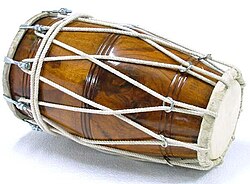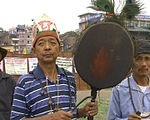Dholak
This article needs additional citations for verification. (April 2021) |
 Dholak drum | |
| Template:Infobox instrument/Classification | |
|---|---|
| Classification | percussion |
| Hornbostel–Sachs classification | 211.22.2 Barrel drums (Instruments in which the body is barrel-shaped, which have two usable membranes) |
| Related instruments | |
| |
The dholak is a two-headed hand drum, a folk percussion instrument. The instrument is about 45 cm in length and 27 cm in breadth and is widely used in qawwali, kirtan, lavani and bhangra. The drum has two different sized drumheads. The smaller drumhead is made of goat skin for sharp notes while the bigger drumhead is made of buffalo skin for low pitch. The two drumheads allow a combination of bass and treble with rhythmic high and low pitches. The body or shell of the Dholak is made of sheesham or mango wood. The larger membrane, played with a stick, has a compound (Syahi) applied which helps to lower the pitch and produce the sound. The smaller drumhead is played with the left hand which produces a high pitch. A cotton rope lacing and screw-turnbuckle are used to release tension while playing. Steel rings/pegs are twisted inside the laces to attain fine tuning. Dholak can be played in three ways — on the player’s lap, while standing, or pressed down with one knee while sitting on the floor.
Construction[edit]
The smaller surface of the dholak is made of goat skin for sharp notes and the bigger surface is made of buffalo skin for low pitches, which allows a combination of bass and treble with rhythmic high and low pitches.[1][2][3]
The shell is sometimes made from sheesham wood (dalbergia sissoo) but cheaper dholaks may be made from any wood, such as mango. Sri Lankan dholaks and dholkis are made from hollowed coconut palm stems.[4]
Usage[edit]
It is widely used in qawwali, kirtan, lavani and bhangra. It was formerly used in classical dance. Indian children sing and dance to it during pre-wedding festivities. It is often used in Filmi Sangeet (Indian film music), in chutney music, chutney-soca, baitak gana, taan singing, bhajans, and the local Indian folk music of Jamaica, Suriname, Guyana, Caribbean, South Africa, Mauritius, and Trinidad and Tobago, where it was brought by indentured immigrants. In the Fiji Islands the dholak is widely used for Indian folk music, bhajan and kirtan.
The dholak's higher-pitched head is a simple membrane while the bass head, played usually with the left hand, has a compound syahi to lower the pitch and enable the typical Dholak sliding sound ("giss" or "gissa"), often the caked residue of mustard oil pressing, to which some sand and oil or tar may be added. The Sri Lankan version uses a large fixed tabla-style syahi on the middle of the bass skin.
Playing style[edit]
The drum is either played on the player's lap or, while standing, slung from the shoulder or waist or pressed down with one knee while sitting on the floor.
In some styles of playing (such as Punjab) an iron thumb ring is used to produce a distinctive "chak" rim sound. In other styles (such as Rajasthani), all fingers are generally used.
Dholak masters are often adept at singing or chanting and may provide a primary entertainment or lead drumming for a dance troupe. Perhaps[according to whom?] the most characteristic rhythm played on the dhol is a quick double-dotted figure that may be counted in rhythmic solfege as "ONE -tah and -tah TWO -tah and -tah THREE-E -TAH, FOUR AND" (rest on "and") or simply a long string of double-dotted notes, over which the bass side is used for improvisation.
On large dholaks, known as dhols, the high-pitched head may be played using a thin (1/4" / 6 mm or less) long (over 14" / 30 cm) stick of rattan or bamboo (rattan is preferred for its flexibility) and the low-pitched drum head using a somewhat thicker, angled stick.[citation needed]
Variants[edit]
The dholki (Hindi/Urdu: pipe or tube) is often a bit narrower in diameter and uses tabla-style syahi masala on its treble skin. This instrument is also known as the naal. Its treble skin is stitched onto an iron ring, similarly to East Asian Janggu or Shime-daiko drums, which tenses the head before it is fitted. The bass skin often has the same structure as in ordinary dholak, being fitted on to a bamboo ring, but sometimes they have a kinar and pleated Gajra, as seen in tabla, to withstand the extra tension. Sri Lankan dholkis have high quality skins with syahi on both sides, producing a sound like a very high-pitched tabla and using a simplified tabla fingering. Steel tuning rings are not used - instead, wooden pegs are twisted to create a very high tension. The heads are created with triple stitching to withstand tension. Similar dholkis are in use in Maharashtra and elsewhere. Heavy hardwood dholaks are said[by whom?] to produce better sound than those carved of cheap unseasoned sapwood.
Similar drums with similar names are found elsewhere in western Asia.
See also[edit]
References[edit]
- ↑ Courtney, David. "Dholak - North Indian Hand Drum". Chandrakantha.com. Retrieved 2013-03-03.
- ↑ "Dholak Sounds pi". Soundsnap.com. Retrieved 2013-03-03.
- ↑ "Information about Dholak, Indian Percussion Instrument". Dholak.com. Retrieved 2013-03-03.
- ↑ "Information about dholak history. Buy dholak – best quality". Tablasitar.net. 2013-02-04. Retrieved 2013-03-03.




